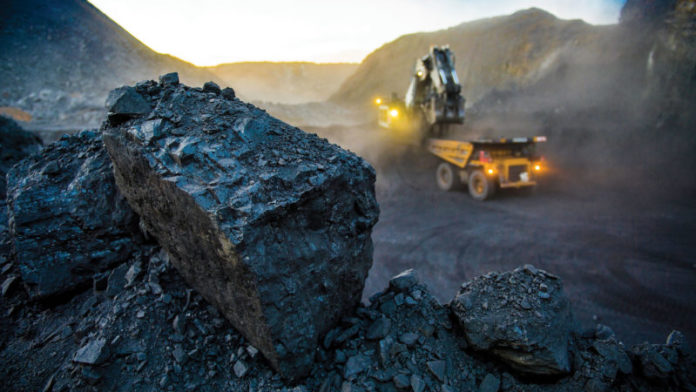
The future of the once-booming South African coal industry is no longer what it used to be or, to use another well-known old saw, the ‘winds of change’ seem to have finally caught up with the sector that produced 259 million tons (Mt) of coal in 2019 and earned total revenues of R139.3bn.
This development is not new because the trend has been noticeable for a while. According to Minerals Council of SA statistics, net investment in the coal industry has dropped from R4.5bn in 2010 to R2.5bn in 2018 despite the fact that more than 70% of the country’s power is generated by burning coal.
But the last couple of years has seen a tsunami of adversity for South African coal producers whipped up by, among others, environmentalist lobbyists who have successfully built up pressure on financial institutions, both worldwide and in South Africa, getting many to agree not to fund new coal projects.
Pressure groups through legal challenges have also managed to block development of one of South Africa’s few remaining thermal coal independent power producer (IPP) projects, which is the proposed 1,500MW Thabametsi plant in the Waterberg.
As of March, Exxaro Resources – which will develop the mine while partner Marubeni will build the power station if it ever goes ahead – was “still hanging in there”, according to head of coal operations Nombasa Tsengwa. But there’s a “drop dead” clause in the contract, which kicks in at the end of 2020 and could kill the project in the absence of clear, favourable indications from government.
The move to renewable energy in the developed world has drastically altered the customer base for South African coal exports. A decade ago the coal went largely to customers in Europe but now go overwhelmingly to Asia, which took 91% of the 72Mt of coal exported by the Richards Bay Coal Terminal (RBCT) in 2019. Two countries – India and Pakistan – dominated, with India taking 41.6Mt and Pakistan 12Mt.
The business bulwark for the South African coal producers has always been Eskom, which last year bought 118Mt of coal equivalent to 45% of South Africa’s total coal production to be burnt in its thermal power stations.
But that business is being eroded. Volumes of coal required by Eskom in the future are being revised downwards because greater quantities of power will be generated from renewable sources of energy.
That’s the clear message following the announcement by mineral resources and energy minister Gwede Mantashe in February when he said the mining industry would be allowed to generate its own power without the need for government licences.
According to Minerals Council president, Mxolisi Mgojo, that is going to take the generation of about 2.4GW of electricity away from Eskom, and the mines intend generating that power using solar installations.
Mgojo also pointed out Eskom will retire some five power stations generating between five and seven gigawatts of power over the next ten years and commented: “… there is no talk about any new coal-fired power stations that will be built requiring Eskom to take any additional coal because they will be superseded by new forms of energy coming onto the grid.”
Minerals Council CEO, Roger Baxter, reckons the freedom granted to the mining industry to generate its own power is likely to be extended to other sectors as well commenting, “… there is a general view that own generation is going to be allowed for everybody”.
Add all that to the slump in power demand caused by the dismal state of the South African economy and you have a situation where previous forecasts of steadily growing energy demand requiring constant development of new coal mines simply does not apply anymore.
ESKOM. LOVE. HATE…
Eskom says it is aware of the situation but will not quantify it at this stage. According to spokesman Sikonathi Mantshantsha: “We are running some scenarios and projections but we are not at liberty to share them at this stage. We will advise stakeholders as and when it is appropriate.”
The South African coal producers have long had a “love-hate” relationship with Eskom. They loved the regular income from the traditionally risk-free business – until the Zuma “state capture” era at any rate – that supplying Eskom power stations on a long-term contract offered.
In the 1980s the major coal producers managed in many cases to ‘piggyback’ successfully on that steady business by developing mines for the more lucrative – but more volatile and risky – export markets. It was a game-changer that led to the rapid development of the Richards Bay Coal Terminal into one of the world’s leading coal export businesses.
They disliked the low prices paid by Eskom and that sentiment intensified from about a decade ago when Eskom controversially changed its procurement policies with the aim of pushing more of its business towards junior black economic empowered (BEE) coal miners.
Cennergi is going to be the stepping stone into our whole renewable energy strategy. – Mgojo
Eskom’s two main changes were to stipulate that companies signing new coal supply contracts had to be 50% plus one share BEE controlled and the utility also moved to increase the volume of coal bought on short-term supply contracts from new BEE coal juniors by cutting back on volumes taken on long-term contract from its traditional suppliers.
The new policies backfired spectacularly on Eskom, which has since rescinded both, but the damage has been done and much of it is permanent.
The BEE control demand – made despite the fact that South Africa’s Minerals and Petroleum Resources Development Act stipulated only a 26% BEE stake in the country’s mines – was rejected by the coal majors, most of whom have since disposed of their Eskom business.
First out was Anglo American, which sold its Eskom-related collieries to Mike Teke’s Seriti Resources and they were followed by Billiton, which unbundled its South African coal business to South32 which is currently in the final throes of selling it – also to Seriti.
The move to short-term coal supply resulted in a sharp hike in the prices paid by Eskom, which was now exposed to domestic spot market prices instead of the low, long-term contract prices it had negotiated with its traditional suppliers.
Eskom also found itself short of coal because the new suppliers often failed to deliver the contracted volumes and there were often problems with the quality of the coal.
But the next fallout from Eskom’s prior decisions is looming, and that is the problem faced by the new breed of South African coal companies: to raise the finance needed to build such new projects as may be required.
NEW ENTRANTS
The “newbie” juniors and mid-tier miners do not have the track record and the strong balance sheets of the majors that have left the business. They are also operating in a financial environment which is actively hostile to funding projects like new coal mines and coal-fired power stations, given their negative carbon emission connotations.
In the past, Eskom has put up its own money to build new collieries, which were then run by the coal companies on a “cost plus” basis but cash-strapped Eskom no longer has that financial option.
According to new Eskom CEO, André de Ruyter: “… financial institutions moving away from funding coal projects is an accelerating global trend. It’s clear, increasingly, as we retire older power stations, the availability of funds to replace such capacity with coal-fired capacity –whether by Eskom or private investors – is going to become constrained.”
If you have private funding, along with the right technical team and the right reserves, then you are going to make money in the coming years in South Africa and that’s why I am optimistic. I see a great future for my companies here – Bayoglu
Despite all of this two businessmen heading up new entrants into the coal sector – Seriti’s Teke, and Menar MD, Vuslat Bayoglu – remain steadfastly optimistic on future prospects.
Menar controls three South African coal operations – Kangra, Canyon Coal and Zululand Anthracite – and, according to Bayoglu: “If you have private funding, along with the right technical team and the right reserves, then you are going to make money in the coming years in South Africa and that’s why I am optimistic. I see a great future for my companies here.”
Teke, who last year declared he was a “coal bull”, says he has not changed his opinion – even though circumstances have forced him to revise his plans to list Seriti, which was scheduled to happen this year.
He comments “… coal still has a role to play and I still see coal as an attractive business for anyone who is cost competitive, reliable and who understands that best mining practices will win the game.”
Both also reckon there are ways around the banks to get finance and point to innovative developments such as “partnerships” with equipment manufacturers; pre-payments from coal trading firms and “buy-own-operate-transfer” deals to build installations like washing plants and rail sidings.
Leading the South African charge into renewable energy is Exxaro – which is black-controlled and already supplies Eskom’s two newest and most important power stations, which are Medupi and Kusile.
In March, Exxaro announced it had handed back to the Department of Mineral Resources and Energy the mineral rights to two major chunks of coal resources in the Waterberg, which it no longer intended developing.
The vehicle for Exxaro’s renewable drive is wholly-owned subsidiary Cennergi but, as of March, Mgojo was keeping his cards close to his chest. He commented that: “Cennergi is going to be the stepping stone into our whole renewable energy strategy, but I cannot give you any specifics now. We are investigating various options and we are not in a position to share what those are.”
The major problem to arise next from all of this is one that faces Anglo American in the proposed disposal of its remaining South African coal assets, which are its export collieries. According to Anglo CEO, Mark Cutifani, the group’s preferred option would be to demerge the division and list it separately on the Johannesburg Stock Exchange.
Those are money spinners under normal conditions, but current conditions are far from normal. The coal export market has collapsed and there appears to be a dearth of buyers in South Africa with the required financial wherewithal to buy them.
The two obvious buyers are Seriti and Exxaro, but neither appears that interested. Teke has effectively ruled out bidding because of likely problems with the Competition Board. Owning the export mines of both South32 and Anglo would make Seriti just far too dominant in the market.
Exxaro previously has been keen on getting greater exposure to the coal export market, but that is no longer the case. Mgojo says the only asset he might be interested in is Anglo’s Mafube colliery, which is a 50/50 joint venture with Exxaro. He’s keen to own all of it.
Glencore and partner African Rainbow Minerals is not interested either, according to ARM CEO Mike Schmidt. Glencore’s strategic decision on its coal business is to wind it down over the economic lives of the group’s remaining collieries.
So, there is a dearth of new coal projects. In fact, there are just two anywhere near start-up at present. One is Resource Generation’s Boikarabelo mine in the Waterberg, which has been stalled for more than five years because of issues around finding the necessary R4.2bn to build the mine.
Then there’s MC Mining’s Makhado coking coal mine in the Soutpansberg section of Limpopo Province, which only needs to find $52m (about R880m).
Both companies say they are almost there in finalising their respective funding packages, but they have been saying that for a while.
All in all it’s a far cry from when “King Coal” was a force to be reckoned with in the South African economy.









